从零手写操作系统之RVOS软件定时器实现-08
- 定时器分类
- 软件定时器的分类
- 软件定时器设计与实现
- 软件定时器调用流程
- 增加对周期性定时任务支持
- 测试
- 优化点
本系列参考: 学习开发一个RISC-V上的操作系统 - 汪辰 - 2021春 整理而来,主要作为xv6操作系统学习的一个前置基础。
RVOS是本课程基于RISC-V搭建的简易操作系统名称。
课程代码和环境搭建教程参考github仓库: https://github.com/plctlab/riscv-operating-system-mooc/blob/main/howto-run-with-ubuntu1804_zh.md
前置知识:
- RVOS环境搭建-01
- RVOS操作系统内存管理简单实现-02
- RVOS操作系统协作式多任务切换实现-03
- RISC-V 学习篇之特权架构下的中断异常处理
- 从零手写操作系统之RVOS外设中断实现-04
- 从零手写操作系统之RVOS硬件定时器-05
- 从零手写操作系统之RVOS抢占式多任务实现-06
- 从零手写操作系统之RVOS任务同步和锁实现-07
定时器分类
- 硬件定时器:芯片本身提供的定时器,一般由外部晶振提供,提供寄存器设置超时时间,并采用外部中断
方式通知 CPU,参考硬件定时器一节的介绍。优点是精度高,但定时器个数受硬件芯片的设计限制。 - 软件定时器:操作系统中基于硬件定时器提供的功能,采用软件方式实现。扩展了硬件定时器的限制,可以提供数目更多(几乎不受限制)的定时器;缺点是精度较低,必须是 Tick 的整数倍。
软件定时器的分类
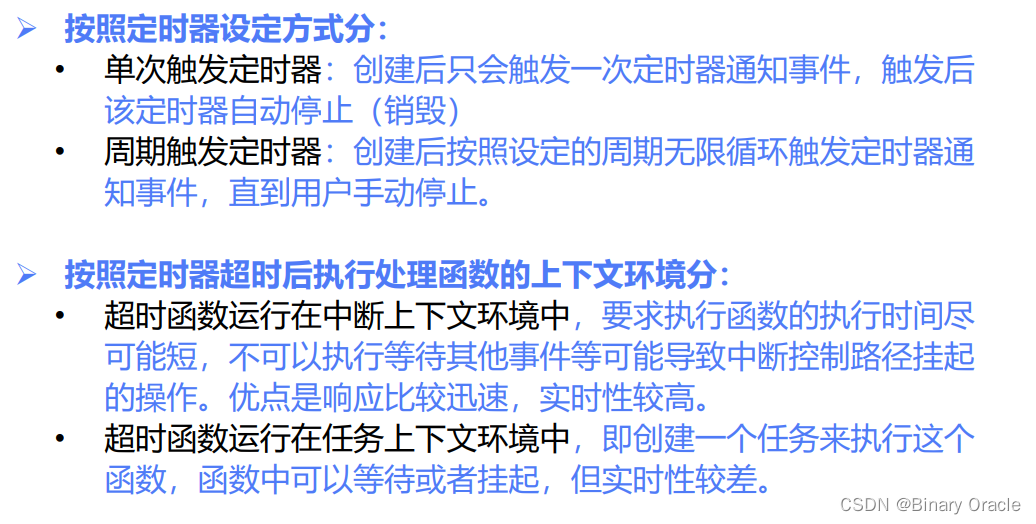
本节采用超时函数运行在中断上下文环境中,因为比较简单。
软件定时器设计与实现
code/os/10-swtimer/os.h
/* software timer */
struct timer {//定时器超时后,任务执行器函数的入口地址void (*func)(void *arg);//参数void *arg;//超时计数器uint32_t timeout_tick;
};
//创建一个软件定时器任务 --- 任务执行器函数入口地址,函数实参,超时时间
extern struct timer *timer_create(void (*handler)(void *arg), void *arg, uint32_t timeout);
//删除一个软件定时器任务
extern void timer_delete(struct timer *timer);
code/os/10-swtimer/timer.c
- timer.c文件是硬件定时器小节新增的,用于实现对硬件定时器模块支持
//最多支持同时存在10个软件定时器
#define MAX_TIMER 10
//采用数组存放软件定时器列表
static struct timer timer_list[MAX_TIMER];
code/os/10-swtimer/timer.c
//在原有的硬件定时器初始化逻辑之上,增加对软件定时器模块初始化支持
void timer_init()
{//初始化所有软件定时器任务struct timer *t = &(timer_list[0]);for (int i = 0; i < MAX_TIMER; i++) {//将每个任务的func和arg清空t->func = NULL; /* use .func to flag if the item is used */t->arg = NULL;t++;}//--------------------下面是硬件定时器模块的初始化逻辑---------------------------------/** On reset, mtime is cleared to zero, but the mtimecmp registers * are not reset. So we have to init the mtimecmp manually.*///硬件定时器模块初始化---传入interval间隔大约为1stimer_load(TIMER_INTERVAL);/* enable machine-mode timer interrupts. *///设置mie寄存器的MTIE位为1,开启时钟中断w_mie(r_mie() | MIE_MTIE);
}/* load timer interval(in ticks) for next timer interrupt.*/
void timer_load(int interval)
{/* each CPU has a separate source of timer interrupts. *///获取当前hartIdint id = r_mhartid();//设置mtimecmp寄存器的值为mtime寄存器的值+interval*(uint64_t*)CLINT_MTIMECMP(id) = *(uint64_t*)CLINT_MTIME + interval;
}
code/os/10-swtimer/timer.c
//创建软件定时器任务
struct timer *timer_create(void (*handler)(void *arg), void *arg, uint32_t timeout)
{/* TBD: params should be checked more, but now we just simplify this */if (NULL == handler || 0 == timeout) {return NULL;}/* use lock to protect the shared timer_list between multiple tasks *///使用锁来保护对共享软件定时器任务列表的操作---此处采用关中断实现spin_lock();//从软件定时器数组中寻找到第一个空位struct timer *t = &(timer_list[0]);for (int i = 0; i < MAX_TIMER; i++) {if (NULL == t->func) {break;}t++;}//如果没有剩余空位,那么返回NULL,表示软件定时器数组满了,创建失败if (NULL != t->func) {spin_unlock();return NULL;}//初始化软件定时任务t->func = handler;t->arg = arg;//_tick变量,记录系统从启动开始到现在为止,产生的时钟中断次数//_tick + timeout表示,从现在开始的第timeout次时钟中断后,软件定时器任务到期//由于本课程中默认设置时钟中断间隔为1s,所以等同于说: 软件定时器任务timeout秒后被调用执行t->timeout_tick = _tick + timeout;//释放锁spin_unlock();return t;
}//--------------------下面是硬件定时器小节添加的逻辑---------------------------------//用于记录
static uint32_t _tick = 0;//发生定时器中断时,会调用该处理函数
void timer_handler() {//不断累加,记录系统从启动开始到现在为止,产生的时钟中断次数_tick++;printf("tick: %d\n", _tick);//本节在定时器中断处理函数中新增对软件定时器任务到期检查timer_check();//重置下一次时钟中断发生时间 -- 1s发生一次timer_load(TIMER_INTERVAL);//进行任务调度schedule();
}
code/os/10-swtimer/timer.c
void timer_delete(struct timer *timer)
{//使用锁来保护对共享软件定时器任务列表的操作---此处采用关中断实现spin_lock();struct timer *t = &(timer_list[0]);for (int i = 0; i < MAX_TIMER; i++) {//定位到目标软件定时器,然后清空func和arg即可if (t == timer) {t->func = NULL;t->arg = NULL;break;}t++;}//释放锁spin_unlock();
}
软件定时器调用流程
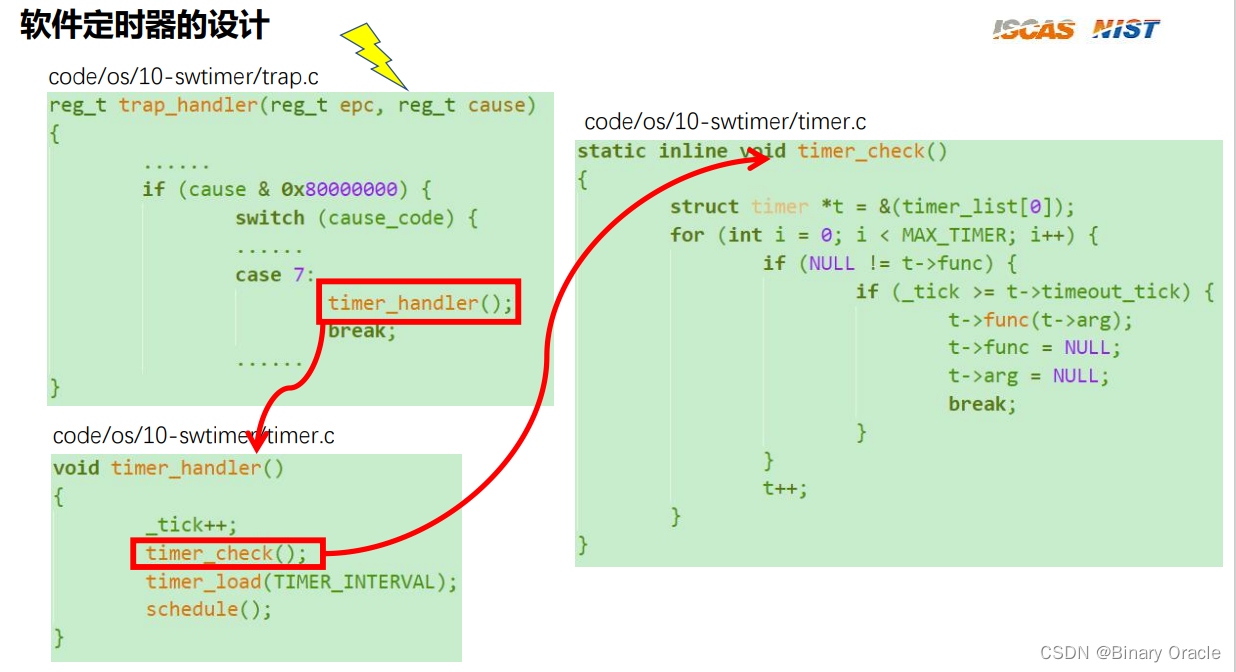
- 时钟中断发生,调用timer_handler函数
- timer_handler函数中首先增加tick数,然后判断是否存在到期的软件定时器
- 如果存在,则直接在中断上下文环境中执行我们的软件定时器任务
/* this routine should be called in interrupt context (interrupt is disabled) */
static inline void timer_check()
{struct timer *t = &(timer_list[0]);for (int i = 0; i < MAX_TIMER; i++) {if (NULL != t->func) {//判断是否有软件定时器任务到期if (_tick >= t->timeout_tick) {//发现一个到期的软件定时器任务,触发任务执行t->func(t->arg);/* once time, just delete it after timeout *///只会触发一次,触发后,就删除当前定时器任务t->func = NULL;t->arg = NULL;//跳出循环,一次时钟中断,最多执行一个到期的定时器任务break;}}t++;}
}
timer_check函数处理思路很简单,如下图所示:
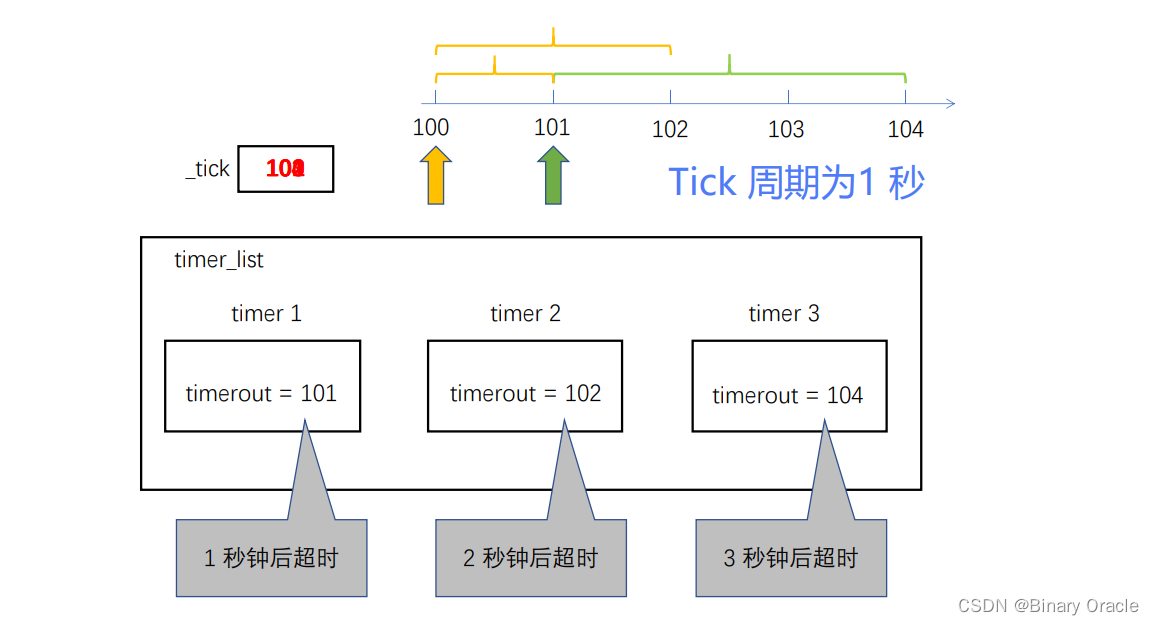
增加对周期性定时任务支持
code/os/10-swtimer/timer.c
- timer结构体中新增两个属性,用于记录当前任务是否为周期性任务和周期性任务触发间隔
/* software timer */
struct timer {void (*func)(void *arg);void *arg;//是否为周期性任务uint32_t period;//周期性触发间隔uint32_t period_time;//下一次触发时机uint32_t timeout_tick;
};
- 定时任务创建:
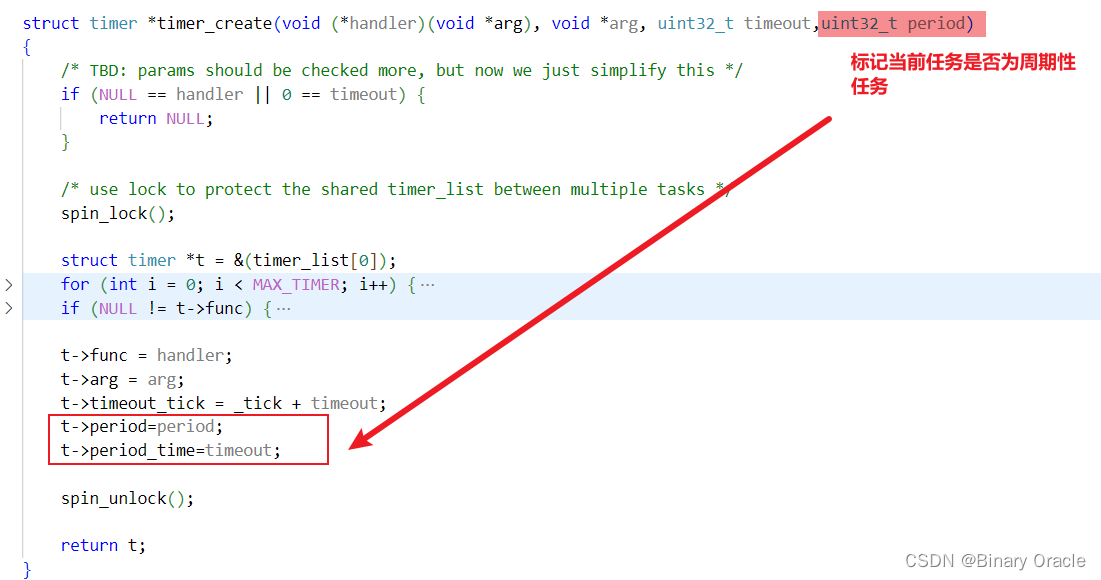
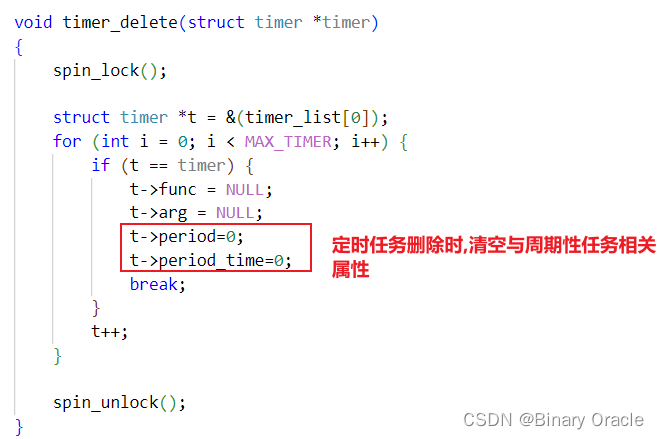
- timer_check函数中增加对周期性任务和一次性任务的区分处理
/* this routine should be called in interrupt context (interrupt is disabled) */
static inline void timer_check()
{struct timer *t = &(timer_list[0]);for (int i = 0; i < MAX_TIMER; i++) {if (NULL != t->func) {if (_tick >= t->timeout_tick) {t->func(t->arg);//非周期性任务,执行完直接删除if(t->period<=0){/* once time, just delete it after timeout */t->func = NULL;t->arg = NULL;t->period=0;t->period_time=0;}else{//更新周期性任务下一次触发的时间t->timeout_tick=_tick+t->period_time;}break;}}t++;}
}
测试
user.c文件中,我们在任务0中创建定时器任务,然后测试其执行效果:
#include "os.h"
#define DELAY 4000void timer_func(void *arg)
{if (NULL == arg)return;printf("%s\n",arg);
}void user_task0(void)
{uart_puts("Task 0: Created!\n");//创建一个周期性任务struct timer *t1 = timer_create(timer_func,"task 1", 3,1);if (NULL == t1) {printf("timer_create() failed!\n");}//下面创建两个一次性定时任务struct timer *t2 = timer_create(timer_func, "task 2", 5,0);if (NULL == t2) {printf("timer_create() failed!\n");}struct timer *t3 = timer_create(timer_func, "task 3", 7,0);if (NULL == t3) {printf("timer_create() failed!\n");}while (1) {uart_puts("Task 0: Running... \n");task_delay(DELAY);}
}void user_task1(void)
{uart_puts("Task 1: Created!\n");while (1) {uart_puts("Task 1: Running... \n");task_delay(DELAY);}
}/* NOTICE: DON'T LOOP INFINITELY IN main() */
void os_main(void)
{task_create(user_task0);task_create(user_task1);
}
期望效果是任务1,在tick=3的倍数时,周期性执行;任务2在tick=5时,执行一次,任务3在tick=7时执行一次:
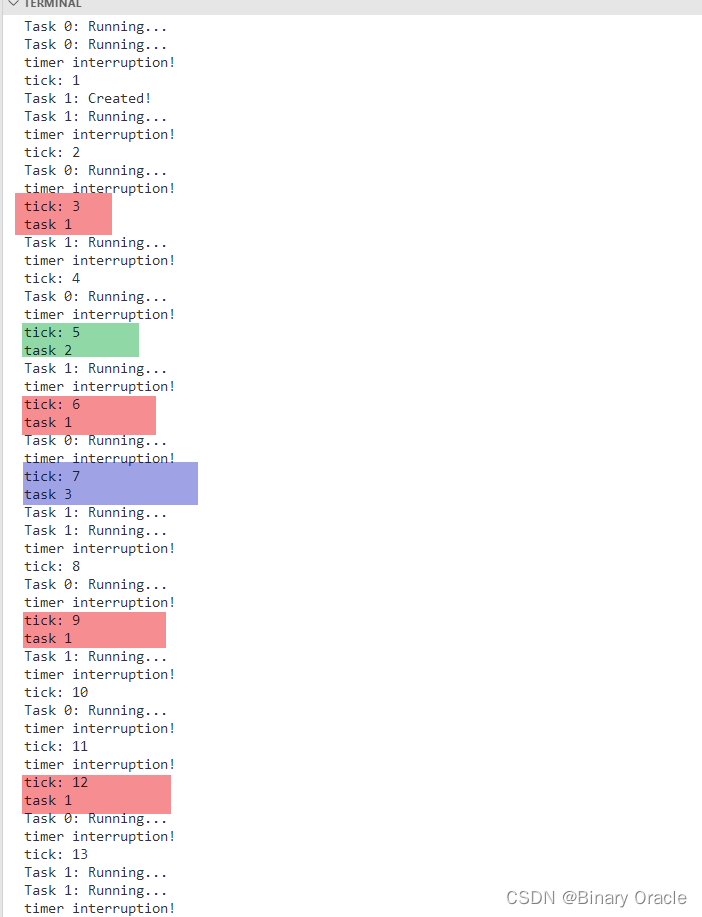
优化点
我们目前使用数组结构来管理我们的软件定时器列表,在软件定时器任务的创建,删除,查找过程中都涉及到大量遍历操作,虽然实现简单,但是效率很低。
如果要进行优化,有两个简单的思路:
- 定时器按照超时时间排序,这样可以加速中断处理上下文判断是否存在到期的软件定时器任务
- 链表方式对定时器实现管理,更加灵活

但是,光是单链表还不足以满足我们的需求,因为单链表的遍历效率同样很低。
可以考虑跳跃表(SkipList),通过多级链表形成类似B+ Tree的索引结构,加速CRUD的过程:
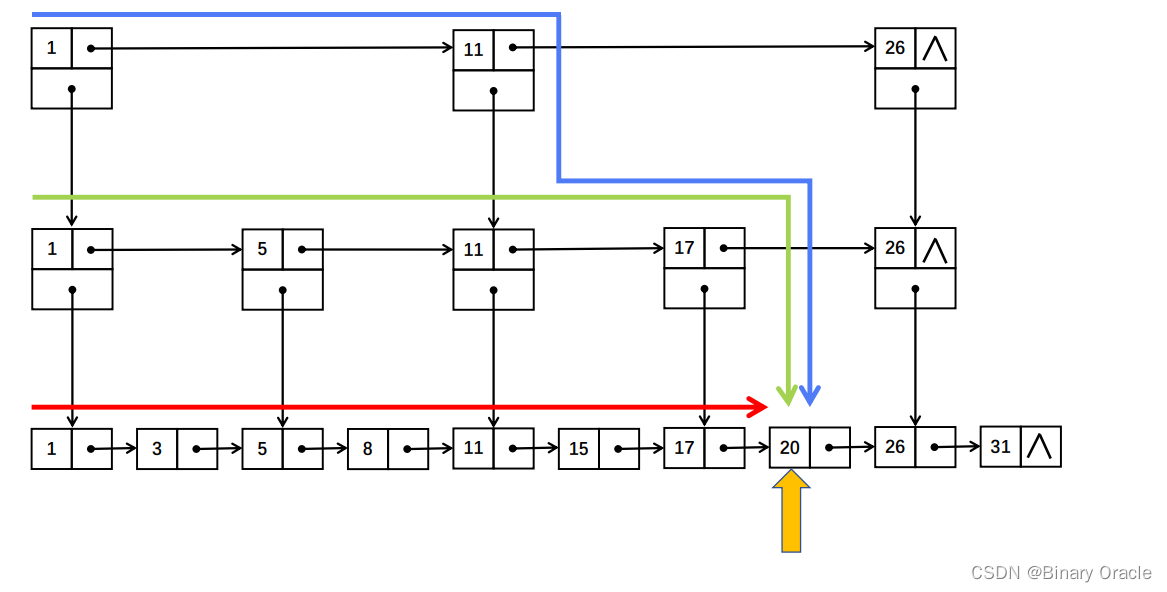
跳跃表实现相较于红黑树而言,实现更简单,并且查询复杂度也是O(logn),大家可以尝试在本节代码基础上,采用跳跃表作为软件定时器列表底层实现。
还有一个优化点就是大家可以尝试将定时任务执行挪动到任务执行上下文中去,可以考虑每个定时任务创建一个进程执行,或者采用生产者消费者模型:
- 设置一个队列,当timer_check函数检查到有到期的定时任务时,就丢到队列中去
- 然后可以是单进程或者多进程组成进程池,在队列中有任务中时,就唤醒生产者进行消费
- 没有任务时,就挂起当前进程




